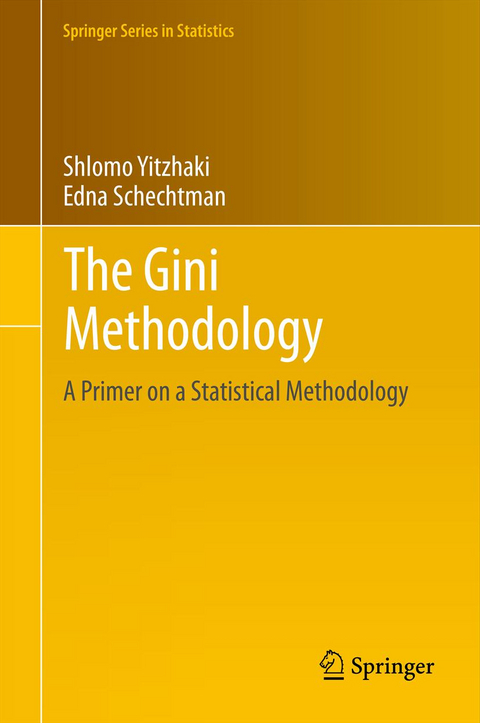
The Gini Methodology
Springer-Verlag New York Inc.
978-1-4614-4719-1 (ISBN)
This book focuses on imitating analyses that are based on variance by replacing variance with the GMD and its variants. In this way, the text showcases how almost everything that can be done with the variance as a measure of variability, can be replicated by using Gini. Beyond this, there are marked benefits to utilizing Gini as opposed to other methods. One of the advantages of using Gini methodology is that it provides a unified system that enables the user to learn about various aspects of the underlying distribution. It also provides a systematic method and a unified terminology.
Using Gini methodology can reduce the risk of imposing assumptions that are not supported by the data on the model. With these benefits in mind the text uses the covariance-based approach, though applications to other approaches are mentioned as well.
Shlomo Yitzhaki received his B.A. in Economics and Statistics from The Hebrew University, and his M.A. in Economics Cum Laude and Ph.D. from The Hebrew University. He is currently Government Statistician at the Central Bureau of Statistics, Israel and Professor Emeritus, Dept. of Economics, at the Hebrew University, Jerusalem. Shlomo Yitzhaki was the recipient of the annual prize of the Israeli Data Processing Association in 1974 for the construction of a Tax Model. Besides significant public appointments with the Israeli government, he was a consutant at the World Bank and held visiting scholar positions at Harvard University, Falk Institute, and the Hoover Institution. Shlomo Yitzhaki has served on the board of many prominent economic journals including: Economics Bulletin, National Tax Journal, The Journal of Economic Inequality, Review of Income and Wealth, and European Journal of Political Economy. Edna Schechtman received a B.Sc. in Mathematics and Statistics, Hebrew University of Jerusalem (1971); M.A. in Statistics, Hebrew university (1976); Ph.D. in Statistics, Ohio State University (1980). She is a professor of Statistics at Ben Gurion University, Israel. Her main research interests are in the field of measures based on the Gini index as well as in applied Statistics in various areas such as medicine, road safety, quality control and more. She published over 100 papers in the professional literature. Professor Schechtman was the president o f the Israeli Statistical Association. She recently spent 6 months at Stern business school at NYU and one semester at the department of Statistics at Berkeley as a visiting scholar and is a frequent visitor of the department of Statistics at Texas A&M university.
Introduction.- More Than a Dozen Alternative Ways of Spelling Gini.- The Gini equivalents of the covariance, the correlation and the regression coefficient.- Decompositions of the GMD.- The Lorenz curve and the concentration curve.- The extended Gini family of measures.- Gini Simple Regressions.- Multiple Regressions.- Inference on Gini-based parameters -estimation.- Inference on Gini-based parameters -testing.- Inference on Lorenz and on Concentration curves.- Introduction to applications.- Social welfare, relative deprivation and the Gini coefficient.- Policy Analysis.- Policy Analysis Using the Decomposition of the Gini by non-marginal analysis.- Incorporating poverty in Policy Analysis - the Marginal Analysis case.- Introduction to applications of the GMD and the Lorenz curve in finance.- The mean-Gini portfolio and the pricing of capital assets.- Applications of Gini methodology in regression analysis.- Gini's multiple regressions: two approaches and their interaction.- Mixed OLS, Gini and extended Gini regressions.- An application in statistics - ANOGI.- Suggestions for further research
| Erscheint lt. Verlag | 13.11.2012 |
|---|---|
| Reihe/Serie | Springer Series in Statistics ; 272 |
| Zusatzinfo | XVI, 548 p. |
| Verlagsort | New York, NY |
| Sprache | englisch |
| Maße | 155 x 235 mm |
| Themenwelt | Mathematik / Informatik ► Mathematik ► Wahrscheinlichkeit / Kombinatorik |
| Sozialwissenschaften ► Soziologie | |
| Wirtschaft ► Volkswirtschaftslehre ► Makroökonomie | |
| Wirtschaft ► Volkswirtschaftslehre ► Ökonometrie | |
| Schlagworte | ANOGI • ANOVA • economic models • Gini coefficient • Gini's mean difference • GMD • Ordinary Least Squares • Regression |
| ISBN-10 | 1-4614-4719-4 / 1461447194 |
| ISBN-13 | 978-1-4614-4719-1 / 9781461447191 |
| Zustand | Neuware |
| Haben Sie eine Frage zum Produkt? |
aus dem Bereich


